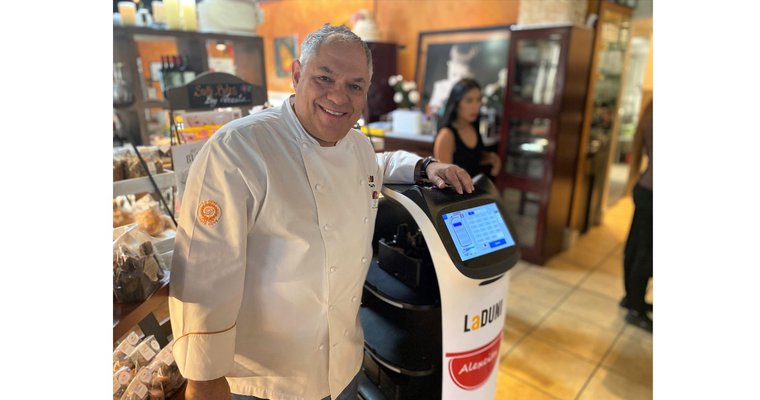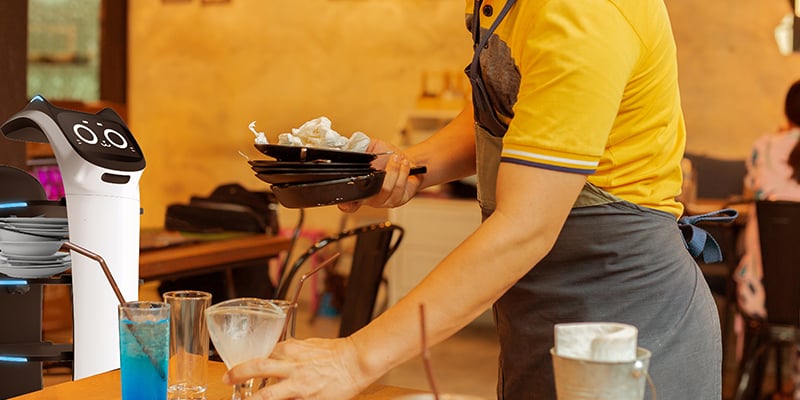
Taco Borga, a restauranteur who’s been at the forefront of implementing technology solutions in the hospitality industry since 1980, discussed how robotic solutions have successfully transformed his business. From solving staffing issues, to reducing waste and spillage, to increasing efficiency, using robots has helped Borga create a better, more profitable restaurant. Here’s how.
Who is Taco Borga?
Borga owns La Duni, a popular, full-service Latin restaurant based in Dallas, TX. Borga began his hospitality career in the fast-casual space and has spent his over 40 years in the industry looking for ways to solve the most pressing issues in the restaurant business.
Like many restaurateurs, Borga was crushed by the pandemic, which forced him to shutter several of his businesses. Although his dedication and strategic approach allowed him to save La Duni, the staffing issues he faced in the wake of Covid inspired him to take a new approach — robots.
How Does Borga Use Robots in His Restaurant?
Borga has five robots ‘on staff’ at his 3,000-square-foot restaurant. Each robot has a specific role: running food, running drinks, bussing tables, bringing silverware and water to new tables when they’re seated, and interacting with guests.
Staffing Issues = Solved
Even before the onset of the pandemic, staffing was a major issue for Borga. After Covid, finding workers became nearly impossible. Not only was he having trouble finding people who wanted to work, but he was also running into the recurring issues of people only wanting to work on certain days, and only being willing to work for short amounts of time.
Given the dire situation, Borga often found himself at a loss when he needed to handle staff members who were late or called out at the last minute. Since knew he wouldn’t be able to replace them, he didn’t have enough recourse to deal with punctuality problems or scheduling conflicts.
Adding robots to the team helped fill the gap and made it possible for his restaurant to operate with significantly fewer staff members on the floor — and at full capacity. Since bussers and runners are extremely difficult positions to fill, robotic solutions that are specifically designed for their tasks made a world of a difference for his business.
Using robots has also provided his staff with a sense of relief, since they no longer have to worry about being left ‘in the weeds’ by a support staff member calling out or being late. Robots show up on time, every time.
Robots Increase Efficiency
Thanks to robots, Borga’s restaurant now runs like a well-oiled machine. Not only does employing robots to run food and drinks save his staff member’s arms and backs (repeatedly lifting and carrying heavy trays adds up), but it also allows food to be taken out more quickly. Where his food runners could only carry one table’s worth of food at a time, his robot can carry four.
The speed of service has quadrupled.
Not to mention, having a dedicated robotic drink runner prevents the carefully crafted cocktails that his bartenders shake and stir up from dying on the service bar because there’s no one available to run them. There are also 22 espresso drinks on the menu that need to be run promptly to maintain quality, so having a robot there to pick up drinks saves them from having to be re-made, and from money literally being poured down the drain.
According to Borga, one of the best things about using robots in his restaurants has been their ability to solve a problem he’s been struggling with for 40 years — the need to have a server present when (or very shortly after) food hits the table. Even the best food runner doesn’t know which dish each guest ordered, and people often mistakenly grab the wrong items.
Having a server ready to assist saves people the frustration of needing to flag a server down after their food has arrived and they’re ready to dig in.
Robots Make for a More Customized Customer Experience
According to Borga, the benefits of using robots are felt just as much by his customers as they are by his business. Robots allow guests to enjoy a more intimate dining experience — at their own pace. Since they can order directly from a robot, customers’ conversations won’t be interrupted by a server inquiring if the table is ready to order, and guests can make the process as quick or as leisurely as they please.
Better Service Means Better Wages
Although many service workers fear for their livelihoods in the face of robotic innovation, in reality, robots have actually helped Borga’s entire staff make more money. With the help of robots, the floor staff can accommodate more guests, more efficiently. Plus, since the tip pool is distributed between fewer staff members (since no one wanted to fill the busser and runner positions anyways), everyone takes home a significantly larger cut.
Borga’s restaurant has been enforcing a service charge on all of its orders since Covid to help offset the increase in takeout orders (which customers usually don’t tip on), and this fee is also distributed to the staff in the kitchen. Many guests still tip on top of this fee because of the seamless service the robots allow them to receive, so the earning potential for Borga’s staff has increased dramatically.
More Than a Machine
Another misconception about using robots in a restaurant setting that Borga is quick to dispel is the idea that robots can’t enhance the dining experience by imparting a sense of fun and personality. Robots are able to entertain, engage, and delight customers both young and old. Since they’re fully programmable, they can interact with humans in endless ways.
Borga is a strong advocate for giving each robot personality. All of his robots have names, and they act as top-notch brand ambassadors that not only tangibly improve guests’ dining experiences, but who also add a ‘wow’ factor that makes dining more joyful and fun.
An Investment that Pays for Itself
Not only does adding robots to the team boost profits by increasing the number of customers that can be accommodated during any given service, but they also do wonders in terms of reducing waste and spillage.
Before he began using robots to deliver food to tables, Borga used to encounter his staff dropping one to three trays per week, on average. Since each tray is usually worth $150-$300, those accidents added up to a big financial problem. Since robots aren’t prone to human error, Borga’s restaurant hasn’t lost a single tray since making the switch, and the money he’s saved in spillage quickly paid for the initial investment in the robots.
Borga’s Tips for Successful Integration
Given his success integrating robotic solutions in his restaurant, Borga has a few practical tips for anyone interested in putting this groundbreaking technology to use. His main piece of advice is that, like most things, adding robots does entail a learning curve.
Although the robots can be up and running within 45 minutes of receiving them, finding ways to make them work to the best of their abilities can take some trial and error. Luckily, in Borga’s experience, troubleshooting minor issues — like teaching the robots the best place to stop in front of a table — is easier than adding a menu item to the POS.
This learning curve also exists for customers. Many guests don’t automatically know how to interact with the robots, but learning is easy and enjoyable.
Since servers are still there to assist, people catch on quickly and the process is smooth even for first-time users.
Borga also stresses the importance of finding a few people on staff who really believe in and advocate for using robots. While the encouragement of ownership is important, he also understands that staff members are highly influenced by the energy and attitudes of their peers.
What’s Next?
Borga predicts that the landscape of the hospitality industry will undergo dramatic changes in the next five years — many of which will be spurred by the increasing prevalence of restaurant robots. In the future, restaurants that don’t heavily rely on robots will likely become the exception and will likely be relegated to concepts that are very high-end and expensive.
Robots also open up new ways to handle scheduling and staffing. Since robots do so much of the heavy lifting, it’s possible that in the future workers may be able to come in for ‘micro shifts’ where they’re just needed for a few hours to help handle the rush. With the help of robots, there’s the possibility that some human staff members can act more like flexible contractors and can be hired through staffing platforms.
At the end of the day, Borga believes that robots can be used in all types of restaurants, but that it’s crucial to work with a partner like ROBOTLAB to discover and utilize the functions in which employing them makes the most sense.
Discover more about Restaurant Robots with RobotLAB!


